Bill Johnson's Steam Trip Journal
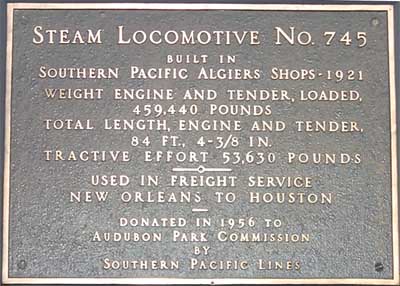

In December 2004 and early 2005, Big South Fork Scenic Railway engineer Bill Johnson was part of a historic steam mainline railroad trip. The hard working members of the Louisiana Steam Train Association leased Southern Pacific 745, the only surviving Louisiana built steam locomotive, and hired Greg Dodd of Dillsboro, NC to restore this grand old locomotive back to operating condition. Engineer Johnson was hired to operate this historic oil burning steam locomotive on the main line for the first time in over 48 years in December 2004. In March - May of 2005, the locomotive was used to power the Louisiana Purchase Bicentennial Train on a 25 city, 1000 mile tour with Eng. Johnson at the throttle. Following is the journal that he kept during the trip:
Read excerpts about this trip from TRAINS MAGAZINE
Monday March 28, 2005
Fireman David Bartee flew from Knoxville and I flew from Lexington and we met at our connection in Memphis. Our Memphis – New Orleans flight was cancelled due to mechanical problems so we had to rent a car and finish the trip. We had Keith Bonnette and Bill Morris go ahead and start firing the engine while we were on the road. When we arrived at the LASTA yard 745 was just beginning to build a little bit of heat. David took her to about 50 pounds and then shut her down for the night.
Tuesday March 29, 2005
Today we finished building steam and the rest of the LASTA crew put finishing touches on the train. We met the New Orleans Public Belt RR at 15:00 and they towed us to the Kansas City Southern interchange at Lambert Junction. Ted Wax piloted us on KCS. We stopped for the signal at the interlocking with the old IC line and Amtrak’s Sunset Limited crossed in front of us with three private cars on the rear. We then got the signal and we continued the move to the south interchange with Amtrak. Amtrak locomotive 508 picked us up and took us the rest of the way to the New Orleans Pubic Terminal where we were spotted head in against the bumper block.
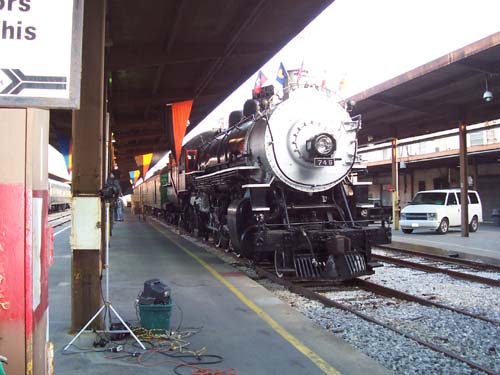
Early morning, March 30 at the New Orleans Public Terminal
Wednesday March 30, 2005
David, Bill Morris and I had to be at the station for TV interviews with CBS affiliate channel 4. Later in the day I did an interview with Louisiana Public Broadcasting who has been documenting a lot of the work with 745. One of the visitors to the train was an old gentleman who was a switchman on the job that hauled 745 dead in tow over the Huey Long bridge in 1956 when she was placed in the park. They took pictures of him and me together since I was going to be one of the crew to take her back over the bridge under steam. Lee Gautreaux showed up with a guitar so we picked on the platform for a little while. Some of the LASTA gang jokingly put a plastic bin in front of us and threw some pocket change in it. Some of the public walked by and threw dollar bills in so we raised about $6.50 which we added to the donation pot. Tonight we drove to Ray and Marie Duplechain’s and had a wonderful dinner and visit.

Bill Johnson and Lee Gautreaux pickin' on the platform.
Thursday March 31, 2005
Today was a relatively easy day. We ran errands in the morning picking up some more equipment and provisions and then went down to the train about noon. The public was still coming and another 600 folks toured through the train. This evening, Jon Stern, the videographer, had a party in the Jefferson Car for all the actors who helped make the 6 videos that are playing in the theater cars.
Friday April 1, 2005
Today didn’t get off to a good start. I received a call from the conductor of the Amtrak yard job that they couldn’t couple to our train because a blue flag had been placed behind it. There are only four of us with the LASTA train that can place blue flags and I had to call each of them and verify that none of them had placed it. I also made additional calls and couldn’t find anyone who blue flagged the train. Everyone with Amtrak was insistent that they hadn’t placed it. I completely inspected the train and ascertained that no one was working on the train and that mechanically everything was okay. In the middle of my inspection, I received a call from the BNSF mechanical department wanting to know if there was a motion limiter on the locomotive drawbar. He followed with the statement that if there wasn’t any, that we couldn’t bring it onto their railroad. As I was walking toward the locomotive, I was already trying to figure out how we could get a welder and some steel, but was relieved to find that it was already in place on the engine. Then, I had to finish addressing the issue with Amtrak. Since the mechanical department of both Amtrak and LASTA ascertained that neither had placed the flag, we made the assumption that a well intentioned LASTA member had placed it and not notified anyone. I then picked up the flag and the supervisor of Amtrak Carmen came over and gave me a 10 minute lecture on proper blue flag procedure and then took the flag with him. I later found out that an Amtrak employee had actually placed the flag. The flag incident delayed our departure by 45 minutes. Amtrak pulled us from the terminal, through the KCS interchange and actually spotted us in the KCS yard. The move was accompanied by two Amtrak Special Agents from the terminal to the KCS interchange. The KCS yard job then picked us up and was able to place the entire train in the short leg of the wye. I tightened the front main rod pin on the engineer’s side and one of the side rod pins on the fireman’s side.
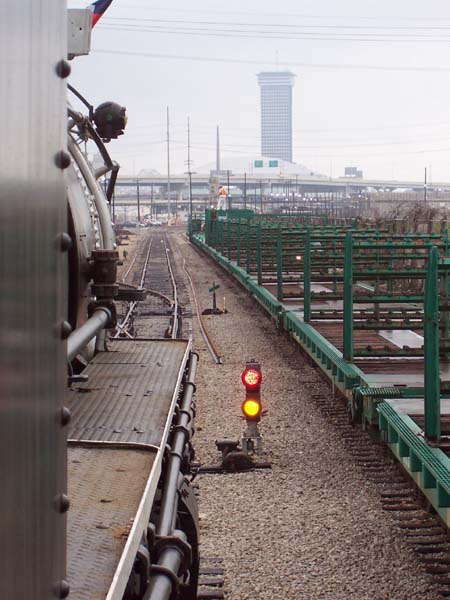
Leaving the New Orleans Public Terminal on April 1, 2005. A rail train is parked on the next track.

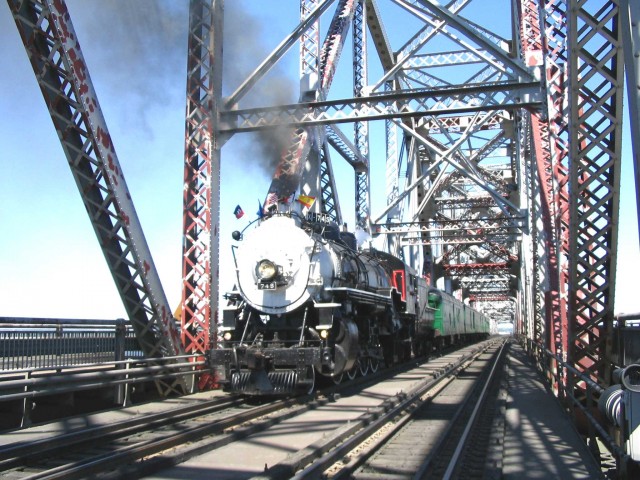
Picture taken from the photographers' highrail truck that was sent to escort the 745 as she crossed the Huey Long Bridge under her own steam for the first time in over half a century.
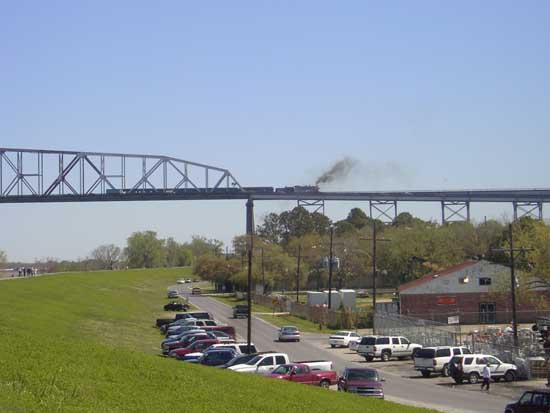

Steaming through the southern Louisiana bayou country.
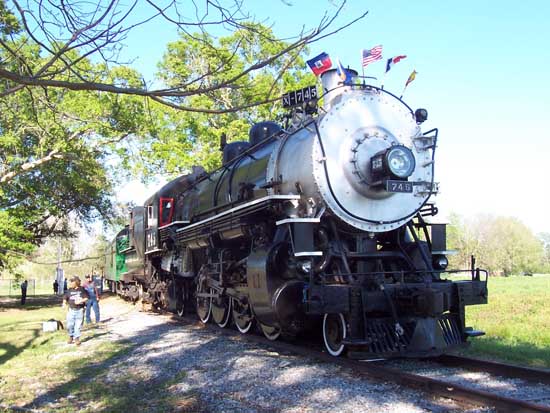
Sunday, April 3
Today was another beautiful day with perfect weather. We had a pretty good crowd of people but had a little snafu when the crew closed the exhibition train at 11 am and started packing up the ramps and the local papers had said that the train would be open until 2 pm. We had to explain about the rigid scheduling and that we had to be ready for our 1 pm departure time. One of the visitors was a fellow who worked with a high pressure lubrication company and saw the crew struggling with the Alemite gun. He borrowed my caliper and measured the button head fittings on the rods which are an extra large size specific to SP locomotives.
We backed out of the stub track on time, pulled to the siding and waited the mandatory 5 minutes before pulling out onto the main. Immediately after getting back on the main, we crossed over the Atchafalaya River on a huge lift span bridge. This is the same bridge that is pictured in the “Homeward Bound” prints that show 745 exiting the bridge eastbound. We later ran over another drawbridge and immediately past that took siding at Baldwin, LA which was our “flag stop”. The ramp was set up to allow visitors from the local Indian tribe who had donated to the train to visit. While the train was parked, UP ran a westbound freight around us and a little later an eastbound Amtrak Sunset Limited passed by. I was on the opposite side of the train helping to keep the public off of the main line while the trains passed by. A little 6 year old girl, Deana Mae, had visited me in the cab about an hour before. She came up with a big grin and gave me a vanilla Moon Pie and a Pepsi. She was a real cutie.
After the traffic had cleared, the crew buttoned up the train and we backed out of the siding onto the main. We then ran mostly on advanced approach and approach signals as we were following the westbound freight that had passed us earlier, but we were able to maintain our 40 mph maximum allowable speed most of the way. We had an unfortunate incident around mp 116 when someone threw a large rock or brick and broke a window in the side of the Jefferson car. Barry immediately called a friend of his who has a glass company and they’re bringing several panes to the train in a day or two.
We arrived at the depot in New Iberia on time and backed into the wye and onto L&D RR’s track which junctions there. We backed the train into a side track and tied it down for the evening. The guy who had met us in Morgan City showed up with an associate and they brought several high pressure lubrication systems with them and had even custom machined a head for one of them to fit our extra large buttons. It’s really been heartwarming to see how much folks have responded to and support the LASTA efforts with the train. Some other folks showed up with a couple of bags of crayfish and an LP boiling pot and the crew had a crawfish boil next to the train. I wanted to see if the restaurant in a little inn in St. Martinville was still open where Jane and I had had a nice meal in 1991 and Ray Duplechain and I drove the 10 miles over to St. Martinville. The inn, which is next to Longfellow’s Evangeline Oak, was still there but looked like the restaurant was closed. There was a phone on the front and I called the number by the phone. The lady said that she had closed the restaurant several years before. She recommended a restaurant called “Possum’s” and we had a good meal there.
The town of New Iberia put us up in the New Iberia Inn. We were given a suite in which Ray Duplechain, Willy Meyers, David Bartee and I stayed. David Bartee accused Ray and I of having a snoring competition but we feel that it was a false accusation since neither one of us heard anything.
Monday, April 4
We had to work though a little bug in getting our track bulletins, but CJ Smith was right on top of it and was able to pick them up from the short line’s office. They took us for a tour of their caboose which was a beautifully worked-over ex-SP caboose. The interior was very plush with air conditioning and captain’s chairs and a small kitchen. It also had a generator set under it.
When we got to the train, Deana Mae and her mother had come to tour the train so I got another nice hug from her. Another family had their little 15 month son, Akel Youman with them and we became buddies too. I had a little last minute scramble before departure to fill the lubricator which had gotten missed and replace a brake shoe on one of the cars. We pulled around the wye, onto the siding an pulled all the way to the west end of the siding to clear the short line for some work they had to do. We waited almost an hour to let a westbound Amtrak Sunset Limited overtake us and then we were cleared to take the main. The Sunset Limited picked up it’s speed to 70 mph and we already had a clear indication on the block when we got to the next signal. Paul Rouchard, our pilot, blew the whistle all the way which really gave me a break. We pulled into the station at Lafayette and I did a quick inspection of the engine and everything was fine. After the inspection, we pulled to the west end of the yard and started to back into the roundhouse lead. We did a quick test of the rods by locking down the brake, opening the throttle a little, then moving the reverser while David and Bill Morris watched the rods. The engineer’s side rod at the crosshead pin showed a little movement. We then backed the train down into the lead and tied down the train. I went to work and checked both rods and tightened the engineer’s side one flat. We visited with a lot of folks, including two older SP retirees who had been active during the steam days during the time that 745 was still active.
A bunch of us went to Prejean’s restaurant which had a Cajun band playing and great food. We stayed the night in the same Holiday Inn where Jane and I stayed during the 1991 AACA Founder’s Tour.
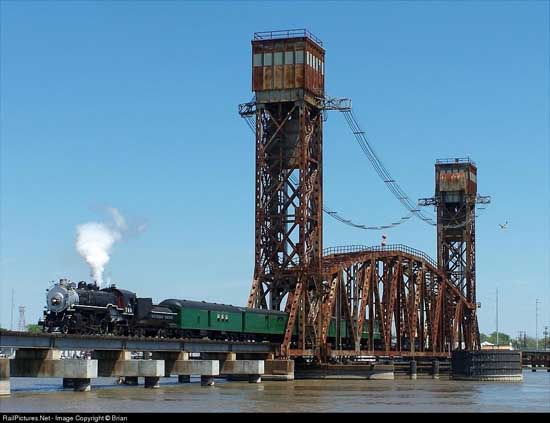
Here's a picture taken of us crossing the Atchafalaya River.

Here we're crossing over the drawbridge near Baldwin, LA.
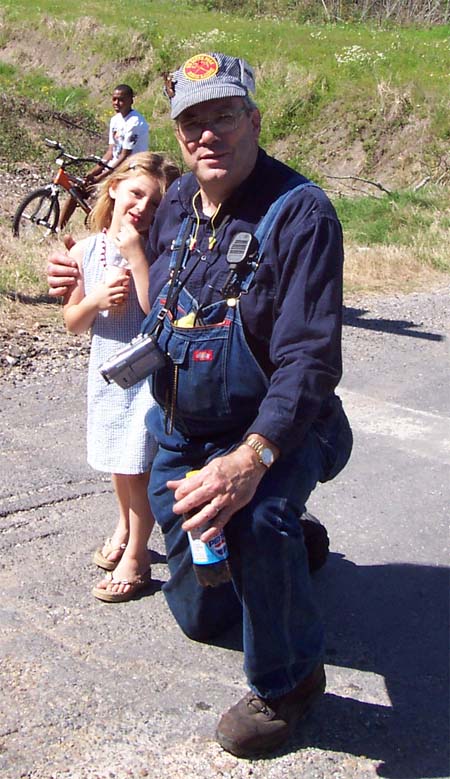
Here's a picture of my new girlfriend Deana Mae Ashley

This is my new buddy Akel.
Tuesday, April 5, 2005
We had a lot more people visit the train today. Since Lafayette is a fairly busy rail center, there are a number of older retired railroaders who visited the train. I especially enjoyed talking with them since they’re literally living history. It’s nice to still have some of the old steam men around. The guys showed up who had set us up with the lubricator rig for the rods. I used it and it really works fast and efficiently. I did several press interviews while we were there.
We buttoned up the train about 1 pm and had our job briefing at 2 just prior to our departure. The crew is still doing a great job and the train was loaded and buttoned up on time. The mechanical department had greased the rail at a crossing coming out of the lead and the locomotive wanted to slip a little but it pulled the 4 cars right out of the stub track without any problem. We pulled to the west end of the yard and had to wait about an hour for a Union Pacific train to get a track warrant straightened out. That situation finally was resolved and the UP train headed west. We got a track warrant and started down the main following the UP train. About that time, we lost the transmit on our cab radio but we were able to get by on our handhelds.
The terrain is starting change to undulate a little bit more and we’re moving out of more swampy territory into a large rice farming area. We tied up for the night on a yard track in Crowley, LA that is parallel to the main line. Since there a several crossings in town, we had to disconnect the locomotive from the train so we wouldn’t block any of them. The mayor and the officials of Crowley threw a reception tonight in our honor that was really nice. The mayor asked us if David Bartee was my son and we’re now trying to figure out who was the most insulted. The city put us up in a brand new La Quinta Inn that is really nice this evening.
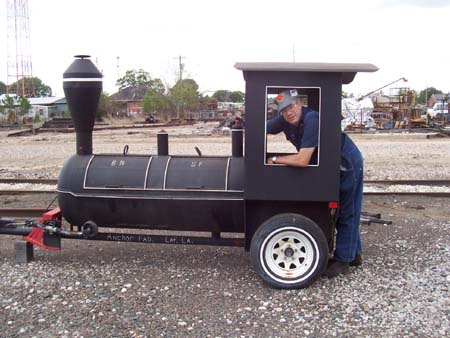
I finally found one more my speed this morning. This is actually a barbeque grill built by the Lafayette Southern Pacific Shops.
Wednesday, April 6
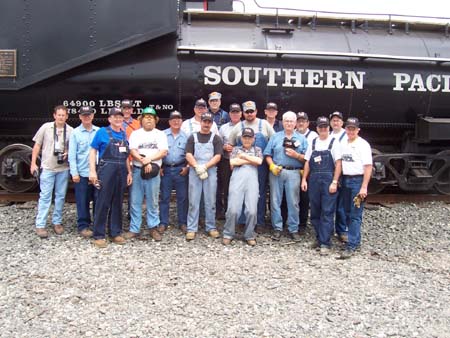
Some of the hard working crew in Lafayette just before departure. It takes a monumental, dedicated effort on the part of many people to make this event happen!
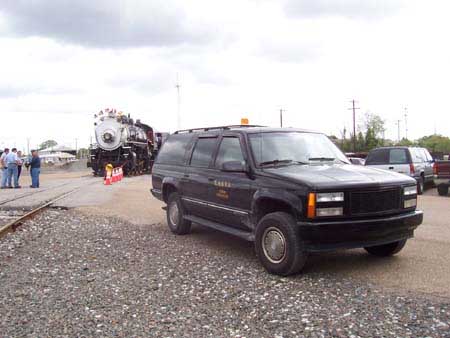
Our other ground transportation.
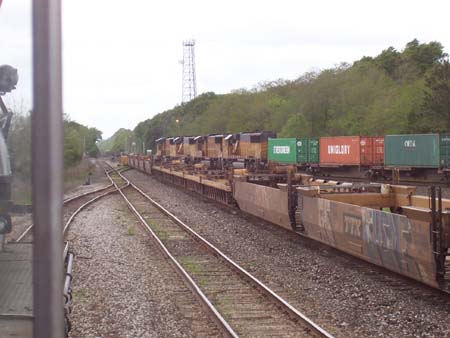
Waiting at the west end of the yard at Lafayette.
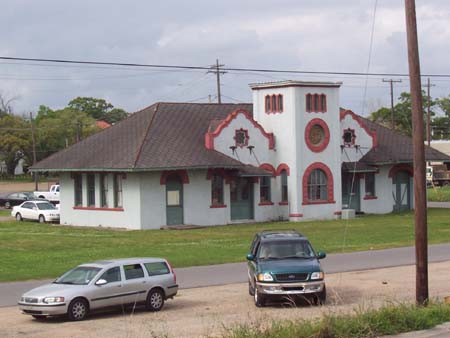
The old Missouri Pacific Station in Crowley, LA. The rail line that once serviced this depot is now gone.
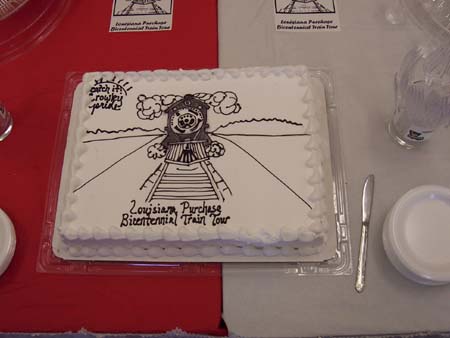
This is the special cake that was among the treats prepared for us by the fine folks in Crowley, LA.
Thursday, April 7
We had a pretty good thunderstorm roll through during the morning hours, but by lunch time the sun was out and thing were drying out. A good number of folks turned out to visit the train including 2 or 3 classes of children.
The BNSF guys, who have been really treating us well, showed up with a replacement radio and installed it for us and also brought us a couple of bags of ice and bottles of ice water which really was a big help. The BNSF folks have been nothing but first rate and extremely supportive of our efforts and we really appreciate them!
We got out of town on time and had a good run today. The locomotive ran really well and we ran our 40 mph maximum authorized speed most of the way. We went through 4 more defect detectors and didn’t trigger any alarms. I let Paul Richard, our pilot, and C. J. Smith, the BNSF Manager of Amtrak Practices, operate the engine some and they really enjoyed it.
We got to Iowa Junction and then moved from BNSF to Union Pacific trackage which we followed all the way through Lake Charles, LA to Westlake, LA. It was interesting to run by the UP Lake Charles yard at track speed. All the folks in their yard office came running out the door to take a look at the locomotive as we sped by. We pulled into the KCS interchange lead at Westlake, LA and a KCS pilot took over and guided us into the yard. We pulled onto the service pad where they filled our tender with water, our sand dome with sand, and the generator car with diesel fuel. We then spotted the train on the Calumet Track in the yard and tied it down. We said our goodbyes to C.J. Smith, Paul Richard, and Leo Persick who had taken such good care of us while we were on their railroad. I jokingly asked them if it would be okay if we just turned the train around and ran back and forth on their railroad which they got a laugh out of. A nice lady with the local Chamber of Commerce showed up with some wonderful barbeque beef and chicken and all the fixings and we chowed down in the KCS crew room. There were a good number of people there so hopefully there will be a good turnout tomorrow.
We’re staying in the Comfort Suites in Westlake this evening.
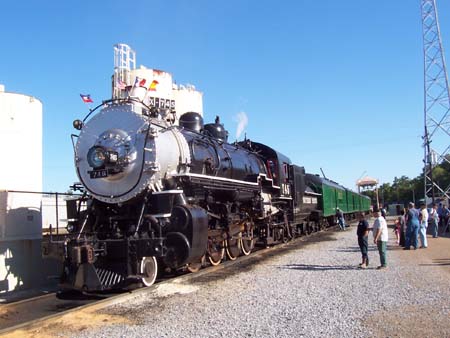
The train is parked on the KCS service pad in the Mossville Yard while we fill the generator car with diesel fuel.
Thursday, April 9, 2005
We had a snafu with the fuel truck delivery the day before and David spent about 3 hours on the phone this morning trying to find someone who could deliver fuel to us. A recycling company brought the proper spec. fuel to us so we now probably have enough fuel on board to make Shreveport.
Today’s trip left from the KCS Mossville yard where the train stayed overnight. We backed out of the Calumet track and onto the yard main. We traveled through the yard, bypassing some cars and a yard engine on the same lead and headed for the north end of the yard. After getting authority from the dispatcher, we entered KCS CTC territory. We had to stay at about 10 mph for a little over a mile past the yard because of an interlocking (crossover) with another railroad. We had a red block at the interlocking, which our pilot Dennis Edwards said almost never happens. When we got on the circuit, the signal changed aspect to an approach and we proceeded to cross the other railroad. Once we got clear of a switch beyond the interlocking, it was up to road speed which was 35 mph. The jointed rail on the line was pretty rough and we did a good bit of pitching around in the cab. We went through the defect detector and it alarmed on #2 L so we stopped to inspect the engine. A thorough check with my infrared thermometer showed all bearings and rods in great shape. I was able to stop the train just short of the next ABS signal, so we were able to resume road speed pretty quickly. The “new” 26 air brake stand in the cab is extremely tight and it’s quite difficult to get in and out of the engineer’s seat. Unbeknownst to me, when I got back into the seat, my bib overalls caught the front sander button and pulled it out. Consequently, I sanded the whole KCS main from the defect detector all the way to DeQuincy.
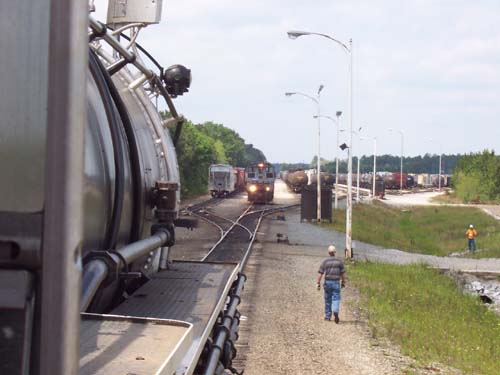
We're pulling into the south throat of the KCS Mossville yard. We'll bypass the yard engine ahead on a side track, pull through the yard, and soon we'll be on the mainline heading north to DeQuincy, LA.
There’s another interlocking with the UP just south of DeQuincy and we had another red block there that we had to stop for. Mr. Edwards got off the engine to walk forward to the signal box to key the signal when it went approach, so he got back on the engine and we started across. We immediately entered DeQuincy and took the diverging leg of the wye and stopped the train right next to the old DeQuincy KCS passenger station. The DeQuincy “Railroad Days” was in the process of being set up and a number of people came up to see the engine.
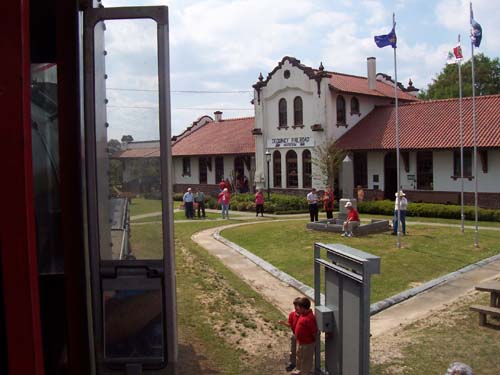
This was our first view of the handsome KCS Depot in DeQuincy, LA.
Later in the evening, we all went across the street to the Iron Horse Pub and had a few celebratory brews. Unfortunately, a karaoke bar and a tired train crew with a few beers is not a pretty sight. Sure was fun, though!
Tonight we’re at the Red Oak Inn in DeQuincy.
Friday, April 9
Today started out with an early phone call from the motel telling us we had to leave our room. After getting this problem worked out, we headed over to the train. We had to get the train ready to move so that we could go into the yard and let the local from Mossville pass over the wye. We’d had difficulty with the replacement radio toning the dispatcher the day before and I decided to try another loaner radio which wouldn’t power up. I put the other radio back in and determined that we could tone okay with the one we have by using a slightly different procedure. After the local passed by, we backed to the station and put the train back on the south leg of the wye. That concluded our operations for the day and we were able to see the rest of DeQuincy’s sights during the day.
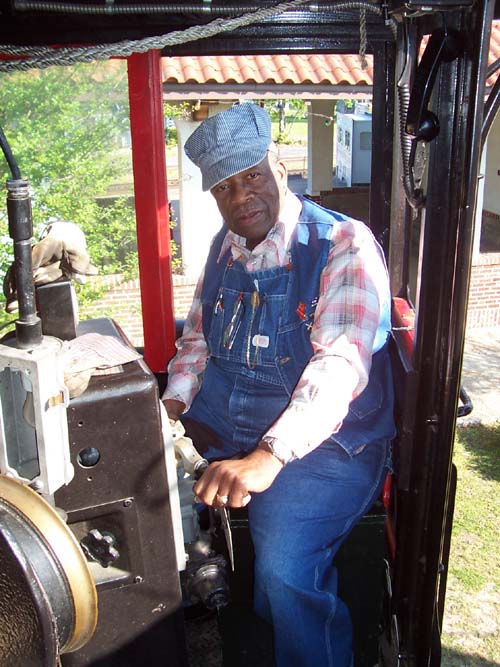
Otha Green was the first black engineer in Louisiana. It's such a pleasure to get to meet and learn from gentlemen such as Mr. Green and to experience true living railroad history.
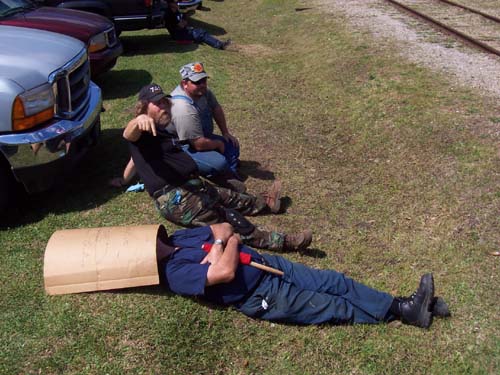
Some of the crew chillin' out in DeQuincy.
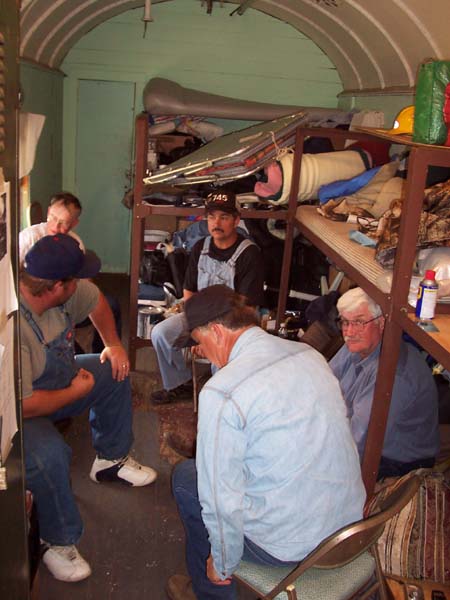
Some special fellowship in the crew car.

A quiet evening in DeQuincy.
We dealt with some minor maintenance issues, then called it a night.
Tonight we’re still at the Red Oak Inn in DeQuincy.
Saturday, April 10
We spent most of the day in DeQuincy. They were having a talent show and we decided that the whole crew would make up one big chorus and sing “I’ve Been Working On The Railroad” with banjo accompaniment by me and harmonica accompaniment from David. After the performance, one of the crew said that we ought to take the act on the road and another crew member reminded him that we already were on the road.

Some of the crew with "Crocky".

Conductor Willy Meyers gets a little rest before departure. We're sure fortunate to have an old hand like Willy on board!
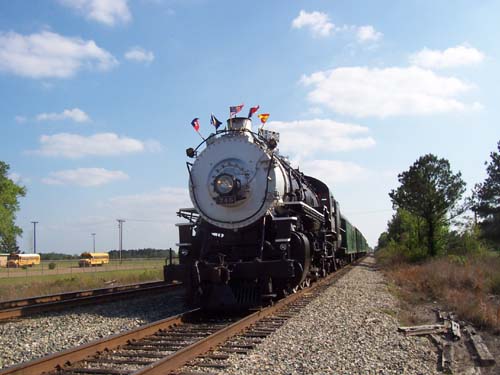
We had to "go in the hole" or take siding at Singer to let two southbound KCS trains pass by us.
We loaded up the train and then backed out of the wye onto the mainline and headed north. We got to Singer, LA where we took siding while two southbound trains passed us and I made an inspection of all journals and rods with my infrared thermometer. Once we were northbound again, we hit one defect detector which said that we were over width but I stopped the train and inspected anyway.

Making a quick inspection stop in DeRidder, LA.
We stopped for about 10 minutes in DeRidder, LA and I did another inspection and everything was fine. We were about 4 miles south of Leesville and smoke started pouring out from the engineer’s front side of the engine so we stopped immediately to see what was the problem. We found that a connecting rod bushing on driver 2R had gotten hot and was on fire. We backed the train into an industrial lead so we could clear the main for another southbound train and pumped grease into the rod bearing until it had cooled down and then proceeded to Leesville. There was a pretty good size crowd waiting for us, especially considering the delay. Mike Hankins, Bill Morris, David Bartee and I found a diner that was open so we could get a late dinner. Afterward, we dropped Bill and Mike off at the train and went to the hotel that had our room reservations. It turned out that the hotel didn’t know anything about us coming and there was a large event at nearby Fort Polk that had all the rooms sold out. We searched for a room and finally found one after midnight at the Country Inn. All they had were smoking rooms, but David and I were so tired that we would have taken anything at that point.
Sunday, April 10
David and I both didn’t sleep well and woke up pretty congested from the smoking rooms. We went over to the train early this morning to move the train from the roundhouse lead onto the main line so the museum/theater cars could be opened up. The KCS RR had us spot the train on the mainline just south of their depot and then ran trains around us on the #1 yard lead! This is the first time I’ve ever seen this happen. After doing some maintenance, Bill Morris, David and I went to get some lunch since none of us had any breakfast. We had a good meal at the Wagonmaster Steak House and then we took Bill Morris back to the train and David and I headed to the Landmark Hotel and checked in. We both got some badly needed naps.
Afterward, we headed back to the train and worked some Teflon compound into the bushing on the rod that got hot and ran the engine back and forth in the yard to run the lubrication in. We kept pumping grease into it and forced out nothing but carbon – no metal flakes, so we’re hoping we’ll be in good shape for the long run tomorrow.
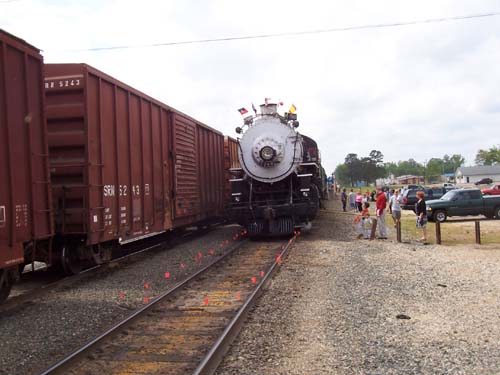
The KCS Railroad had us park the train on the main and ran trains around us in the #1 yard lead. This is the first time I've ever tied up a train on the main, but it made for a safer setup for the train because visitors to the exhibition/theater cars didn't have to cross over any tracks.
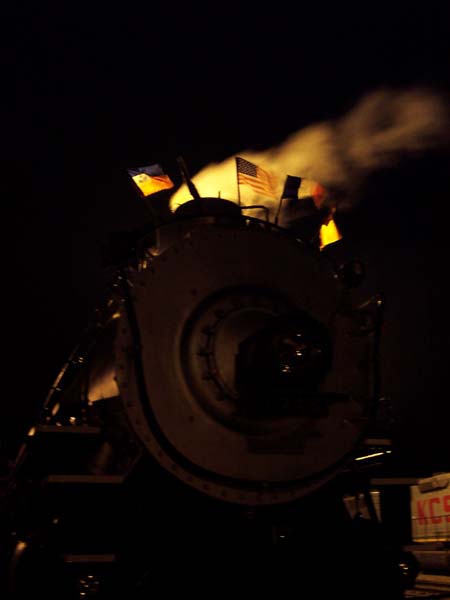
Nighttime in Leesville.
The real crisis is that I’m now out of clean underwear and socks. I decided to wash out some in the sink and then brilliantly decided that I could dry them out quickly with the microwave oven in the room. I’ve now made the discovery that one can set underwear on fire in a microwave. It kind of makes the term “hot pants” take on a whole new meaning!
Monday, April 11
We started the day by attempting to back off the nut on the side rod that was getting hot. We put the rod wrench on the nut, placed a spud bar and a cheater pipe against the wrench, and three of the other crew members pulled the bar against the wrench while I hammered on the wrench. We were only able to move the nut about ½ flat after 20 minutes and had to give up since we were already past our scheduled departure time. Ray Duplechain held another pre-trip briefing and we got on board and headed to the main.
We ran along for a couple of miles and hit an absolute CTC block and had to stop for the signal. While we were stopped, we checked the rod and it was beginning to gain in temperature. We greased it and finished just as the dispatcher gave us a high green. We stopped two more times to put grease in the rod before our water stop in Zwolle, LA. While the engine was being watered, the sky started getting dark. I ran over to a Western Auto store next to the tracks and bought some powdered graphite which we pumped into the rod. About halfway through the process, the skies opened up and we found ourselves in the middle of a pretty severe thunderstorm. Because of the cool rain hitting the glass, all of our windows started fogging up inside the cab and Bill Morris ran through the rain over to the Western Auto and the nice lady there gave us a squeegee which really helped. We departed during the storm and didn’t get but a mile or two and the rain picked up even more. We had to drop our speed to 5 mph because we were having problems seeing through the heavy rain. Thankfully, after about 15 minutes the rain eased up and we were able to get back up to speed. We observed a lot of lowland flooding and found out later that 4 inches of rain had fallen. I certainly believe it and will insist that Bruce get us lifeboats in case this ever happens again.
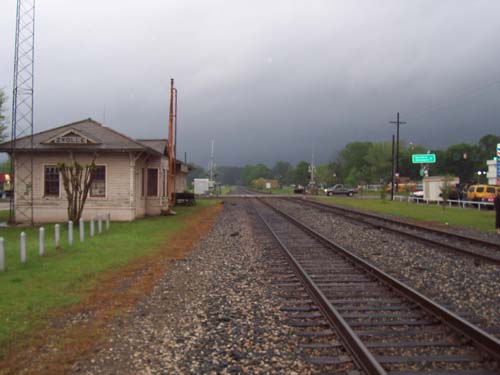
The dark clouds are gathering as we take water in Zwolle, LA. Soon, we'd find ourselves on the mainline in a 4" downpour!
We had to take siding in Mansfield so we decided to hit the rod with grease one more time. The temperature was slowly coming down on the rod pin as we were working lubrication in more and this was the last time we needed to grease it before the 40 miles to Shreveport. It looked like we shut down most of the town in the area of the railroad as folks were coming out of businesses to see the old steamer. We’d also built up a pretty good contingent of chasers by now.

No, the aliens haven't landed! Mike Hankins and his "greasers" are putting a charge of grease on the #2 driver side rod pin in Mansfield, LA.
By the time we got to Shreveport, the weather turned colder but the sun came out and it turned into a nice day. Rail traffic got more congested as we arrived and we followed a rock train for a pretty good distance most of the way into Shreveport Yard. Once we got near the yard, we backed through a crossover onto the parallel main and worked our way into the terminal. We pulled into the roundhouse lead and onto track 454 which would be our new home for the next 10 days.
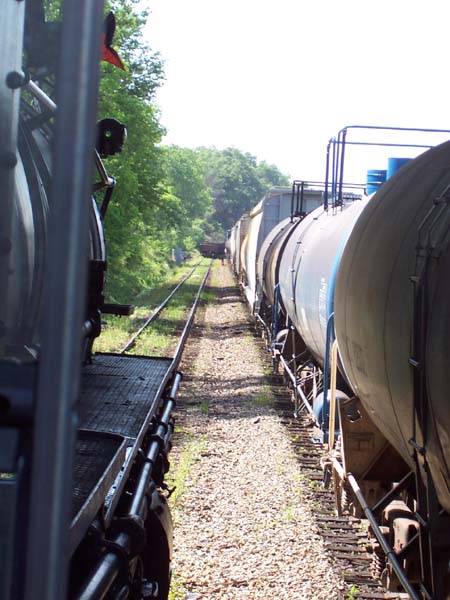
We're still about 3 miles from the KCS Demarcus Yards, but we're already into the congestion getting to the yard. We're passing one train and slowly following a rock train into the yard.
It was a particularly emotional moment for me to pull the old historic steamer into the Shreveport shops as this is near where my good friend J.K. Byrne used to live. We lost J.K. about 8 years ago and I had the hat he had given me on the dashboard of our escort Suburban so he could be along in spirit. My inspection hammer is an exact duplicate of the one that J.K. used to carry and I had gotten the dimensions off of it when he came to work with us on ex-Reader #11 in Paris, KY in the late 1980’s.
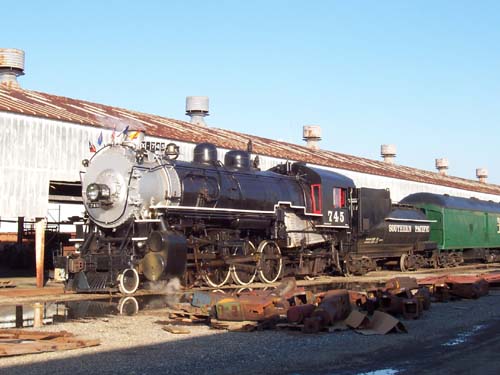
All tied down and put to bed in Shreveport. 745 will now be allowed to go cold and the crew will do her 30 day FRA inspection upon their return in a week. Excepting the one minor rod problem, the faithful old steamer has done a super job of getting us to the halfway point of the tour. Unfortunately, she's parked in an inaccessible secured part of the KCS shop complex and won't be seen by the public until she makes her move to Bossier City on April 23rd.
Once we tied the engine down and dropped the fire, we had a trackside meeting with the local officials so we could discuss the procedure in case they had to move the equipment while we were gone. We stowed our oil cans, cab battery and tools and got ready to depart for our break and a welcome trip home. We got a good laugh out of the guys in the Shreveport Shops when we asked them if they could please service our traction motors while we were gone for the break.
Two carloads of us left to find a good place to eat and we decided that we had gotten too used to not having a steering wheel as we made about 4 wrong turns trying to get to the restaurant. We had a great meal at a seafood restaurant that served huge portions and this was the first time that David and I couldn’t finish a meal. We found a room for the night at the Residence Inn near the airport.
Tuesday, April 12, 2005
David and I got up early and left the Residence Inn at 5 am. I picked up a copy of The Times, the local Shreveport paper, and was surprised to see a color picture of 745 on the front page with a nice article about our arrival. We flew home for a much needed 6 day break.
Tuesday, April 19, 2005
The day started at 5 am. David and I flew back on an early flight to Shreveport on a day that was quite nice. When we got to the Residence Inn where we had made our reservations, we were told that we had no reservations and that they were full. We were finally able to ascertain that they had my name in the computer wrong and that was the problem. After we checked in, we received a phone call that the train would be moved this afternoon to a piggyback yard for media sessions tomorrow morning and wouldn’t be returned to track 454 until 2:30 tomorrow afternoon at the earliest. This has thrown us into a panic since we’ve scheduled our 31 day FRA inspection for tomorrow and the FRA inspector is already in town. This means that we won’t be able to do the 31 day tomorrow since we can’t do a boiler wash at the location where they’re moving the train. After a number of phone calls, we got it worked out where the train will be moved back at 7 am tomorrow morning. We worked on the locomotive to begin preparations for the 31 day.
Wednesday, April 20, 2005
It was another early morning. I left the Residence Inn at 4:45 am to get to the train in time to do press interviews with Channel 4 the local ABC affiliate. Mr.. Richard, a 90 year old retired locomotive engineer who had actually operated 745, was on hand for some interesting discussions and interviews. After wrapping up the TV work, the yard job was notified and they came to return the train to track 454 so we could commence our 31 day inspection. During the move, I was interviewed by John Prime of the Press.
After being moved back to our temporary home on track 454, we started preparing for the inspection. This included removal of the sight glasses and associated piping and running a gun cleaning brush through them. All the washout plugs had to be removed and we hooked a fire hosed up to each washout plug opening to flush accumulated scale and sediment out of the boiler. All six fusible plugs had to be removed from the crown sheet and inspected and reinstalled. After doing a few other procedures, we buttoned up the boiler and filled it with water. Keith Bonnette got stuffed into the firebox so that all the stay bolts could be hammer tested. The FRA inspector passed the locomotive but we had a few minor things that needed to be done to the cars.

Keith Bonnette after just emerging from the fire box after hammer testing stay bolts and removing fusible plugs for the FRA inspection. David Bartee looks on.
After a hard day’s work, we all went to an area Mexican Restaurant where it was dollar margarita night. Thank goodness they didn’t have karaoke like the Iron Horse Pub did in DeQuincy!
Thursday, April 21, 2005
Today we focused our attention to other maintenance issues. First, we had to meet the fuel truck. I repacked the air pump and we also tried to back off the nut on the rod pin that go hot. We were able to back it off some, but it was really tight. We treated the rod pin with a compound that I had mixed up in Lexington before I returned to Shreveport. We also started moving our tools and other equipment back onto the locomotive in preparation for the next leg of our long trip. The locomotive was greased, the air pump serviced and topped off with lubricant, and the mechanical lubricator was filled.
We ran to the grocery store and picked up steaks and other supplies and had a cookout next to the train. We closed out the evening with a couple of rounds of golf inside the Jefferson Car before returning to the Residence Inn and calling it a night.
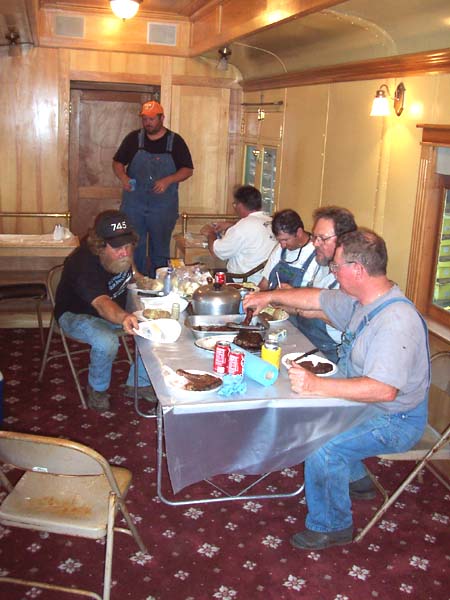
Eating dinner in the Jefferson car.
Friday, April 22, 2005
We finally got to sleep in a little and get some much needed rest. We headed out to the train and started the fire around 11:30 this morning. While building steam, we dealt with a number of additional maintenance items, fueled the locomotive, and Keith Bonnette pressure washed the locomotive. We finished moving our tools and other supplies out of storage in the crew car and back onto the locomotive in final preparation for our departure tomorrow morning. Mike Hankins finished greasing the locomotive and we attempted to pump more grease into the problem pin. The top grease fitting accepted grease fine, but the center fitting on the pin took a lot of pressure but wouldn’t feed grease to the pin. We surmised that the passageways were blocked with carbon from the earlier rod incident south of Leesville and I’m in hopes that my treatment compound will break up the carbon and open the passageways.
Saturday, April 23
The day started out with beautiful weather. A cold front had gone through early this morning and the air was cooler and dryer. This was quite welcome since we’d be sitting in the hot cab for awhile.
We performed our daily inspection and air brake test, our pilot, Jon St. Vigne (actually a Manager of Operating Practices) climbed aboard, and we started our shove back out of the yard. We made it down to the throat of the yard and had to wait for a northbound train to pass so I used the opportunity to attach the grease gun to the problem rod pin and put a little positive pressure in the grease fittings to force more compound onto the pin. Thankfully, the center pin started feeding grease to the pin so we now have lubrication reestablished through both grease fittings. While I was preoccupied with the pin, Bill Morris, who was firing the engine, noticed that the air pump didn’t sound right and was laboring. I checked the pump and found that the secondary piston wasn’t moving and the compressor was no longer delivering air. Over the next hour, we tried every quick fix that we knew. We were able to get the piston to move, but it wouldn’t go it’s full stroke and wouldn’t deliver air. Since we were clogging up the entrance to the yard, it was decided that the most prudent course of action would be to call yard job 132 and let them take us to Bossier City. They did a great job of handling us and I still worked 745 some so that we’d have the steam admission to lubricate the steam chests.
We crossed the Red River into Bossier City via the old Illinois Central bridge. This bridge is a curiosity in that it was originally built as a swing span drawbridge. Since its construction, the river has moved slowly away from Shreveport and toward Bossier City and the center pedestal for the bridge is now slightly inland from the shore.

Crossing the Red River over the old IC bridge.
We were dropped off at the yard and there was a good sized crowd waiting for us when we arrived. This was especially nice of them to hang around since we were delayed by the air pump problem and also by having to wait for two trains to pass.
Upon arrival, I caught a ride in a KCS van with a Trainmaster and our MOP Mr.. St. Vigne. They said that the delay from the air pump had caused some inconvenience to one train but didn’t delay it much and 132 didn’t have a lot of work, so I breathed a little easier. After picking up the Suburban, I immediately drove back to the train.
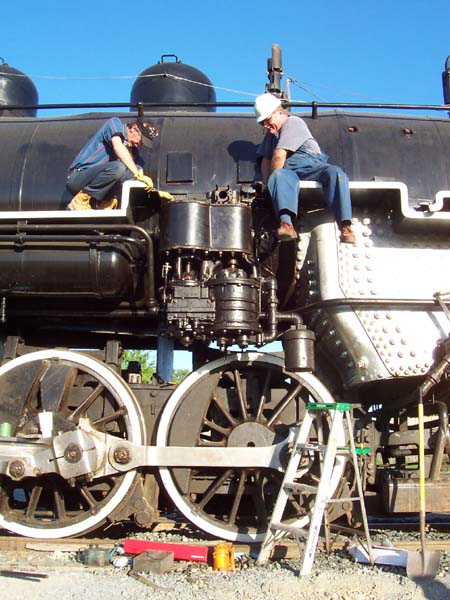
Harry Abbott and Jerry Lynch remove the walkway and start diagnostics on the air pump.
We started working on the air pump to determine the problem. Our initial diagnostics led us to believe that steam pressure was equalizing on both sides of the secondary cylinder steam piston. Upon advice from my friend Scott Lindsay that we may have a blown head gasket that was allowing steam to short circuit within the pump, we removed a section of the walkway and removed the head from the air pump with my chain block. As soon as the head cleared, I discovered a most disappointing sight. The piston rod had pulled completely out of the piston and the piston was missing the bottom third of its threads. A check of the threads showed that the piston rod had not been properly swedged on the end and the piston was merely screwed onto the rod without any final securing means. The piston had unscrewed itself and this was causing the noise that had been plaguing us in the compressor. Without air, this means that we’re literally dead because we can’t operate a locomotive without an air supply for our brakes and our power reverse.

One bright spot during the period with the air compressor problem was a visit from Mr. and Mrs. W. Conway Link. Conway is the son of the late O. Winston Link, a railway/industrial photographer famous for his gift of "painting" subjects with lighting during night photography.
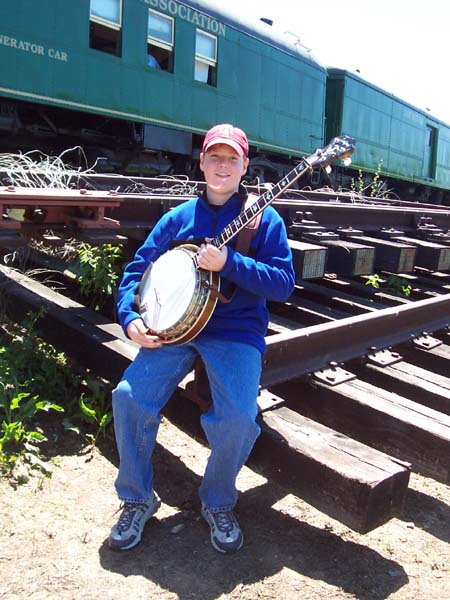
Matt just turned 12 and is quite a banjo picker and I enjoyed hearing him pick a few tunes on my Ledford handmade banjo.
One of the friends I called while we were doing diagnostics was Ron Larson. Ron was originally going to be my fellow crew member on the 745 run and work commitments kept him from getting loose from work. We now think that it was divine intervention because this set up a chain of events which final result was Ron getting the Superintendent’s job at Austin Steam train. I called Ron back to tell him that I’d found the problem and had talked with Bernie Watts about some possible repair options. However, it wasn’t looking good that we had any field repair options. Ron called back in about an hour and asked me if we’d be interested in a loaner air compressor. It seems that 745’s sister MK-5, 786, has been undergoing a heavy rebuild and had a freshly rebuilt compressor still in the crate. I’d already borrowed some grease fittings from Ron from the 786 and it seemed that she once again, with Ron’s patient assistance, be coming to the aid of her disabled sister.
Ray Duplechain called all the crew into the Jefferson car and had a group meeting to discuss the situation ahead of us and to make a go – no go decision regarding our 3:30 am departure on Monday morning which was now looming about 29 hours away. We decided to go for it.
Sunday, April 24, 2005
Jerry Lynch, Mike Hankins, and Harry Abbott had been spearheading the compressor mechanical situation. They partially reassembled the air pump so we wouldn’t lose any parts and stripped the connections from the compressor and loosened the mounting bolts. We made an arrangement with a boom truck operator to arrive at 5 pm, approximately the same time that Ron would be arriving with the loaner air pump.
We made a supply run to Harbor Freight Tools and picked up three large ratchet straps. We decided that we’d crate 745’s compressor in the new compressor’s box and then load it on top of the water tank on the tender just behind the oil tank. There are steel brackets under the walkway that will provide structural anchoring for the tie downs.
The boom truck arrived about 20 minutes early so we got him into position. No sooner had he gotten his outriggers set and his boom extended, than our angel of mercy Ron Larson pulled up with the loaner compressor. We quickly determined that the lifting eye that we had wouldn’t fit the 1 ¼” threads in the top of the compressors. Ron and I took off for the KCS shops and we found some hardware that would suffice.
We hooked up the old compressor to the boom truck and the bolts holding it to the locomotive were removed. The compressor swung free and was temporarily place on the bed of the boom truck so more fittings could be removed. Jerry, Harry, Mike and Ron were in the process of doing this when David, Willy and I had to leave to meet our compliance with hours of service law. As of this writing, they’re still working on the compressor change out which had a bit of a challenge in that the steam supply line attached at a different place on the compressor and we have a very limited supply of pipe fittings on board and it’s Sunday night. We’re hoping that they’ll be successful in getting everything hooked up.
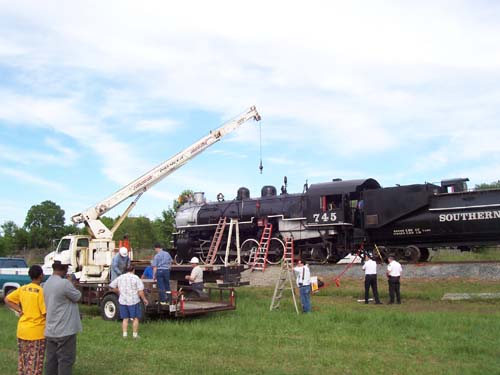
Removing the disabled air compressor.
Monday, April 25, 2005
Today really started early. Willy Meyers, David Bartee and I left the Residence Inn at 2:30 am and headed to the train. When we arrived in Bossier City, Ron Larson and the crew were putting the final touches on the air compressor installation and 745’s original compressor was placed on the tender on top of the water tank and behind the fuel tank. I had picked up 3 heavy duty nylon ratchet straps the day before and they were used to secure the old air compressor.

David and I with our "savior", Ron Larson, Superintendent at Austin Steam Train Association. Ron looks real chipper for a guy who left from Austin during the early hours of the previous day, delivered the air compressor, then worked through most of the night helping the crew get the loaner pump installed.
We started shoving back out of Bossier City Yard at about 4 am. It was a clear night and the moon was almost full. Ron Larson later told me that 745 shot out a perfect smoke ring that circled the moon from where he was standing. We backed out onto the bridge over the Red River far enough to clear the switch lead and then started our trip east in the dark. We triggered an alarm on the next three defect detectors, all #5 on the fireman’s side which is the usual place for the detector to report a problem. We figured that it’s probably triggering on the atomizer line to the burner. We also stopped and checked the rod that had been running hot. It was doing okay, but was a little elevated in temperature and we just stopped every 10 miles or so and pumped some grease into it.
This subdivision was the first experience I’ve ever had with tone lined switches. The territory is DTC (Direct Train Control) but doesn’t have ABS (Automatic Block Signals) in between the DTC control points. Instead, each switch for the siding must be addressed by transmitting a series of keyed tones over the radio to the switch. When properly addressed, the switch either shows a green indication on its signal and give a verbal confirmation over the radio that the switch is line normal or gives an approach (yellow) indication and gives a verbal confirmation that the switch is lined reverse (diverging). It worked well except for one switch which wouldn’t respond to a tone so we had to stop and hand throw the switch before proceeding.
Just before Simsboro, LA, we overtook a rail grinder. When we got to the west switch at Simsboro siding, we took siding and backed the train onto a rock company spur so that we were completely clear of both the main line and the siding. There was a tie gang working on the mainline ahead of us, and since we had left late from Bossier City, we had missed our opportunity to get past the tie gang before they started their work. Since we had a long way to go and we were concerned about our 12 hour of service limit, it was decided to park the train and have Willy Meyers, David Bartee and me take a 4 hour rest period. We headed over to a country store called Magnolia Corners and had a big breakfast. I took a nap in one of the rocking chairs in the store and David took a nap in the back seat of the Suburban. Just before noon, we headed back to the train. Keith and Bill had everything ready to go. Fire Chief Charlie Edwards had driven his 1928 Ford Phaeton over and it was nice to see an old car. We visited for a few minutes while Jon St. Vigne got us authority to enter the line and then we were on our way. As we were leaving Simsboro, we passed the school and all the kids were out on the lawn to watch the train travel by and cheered as we passed.
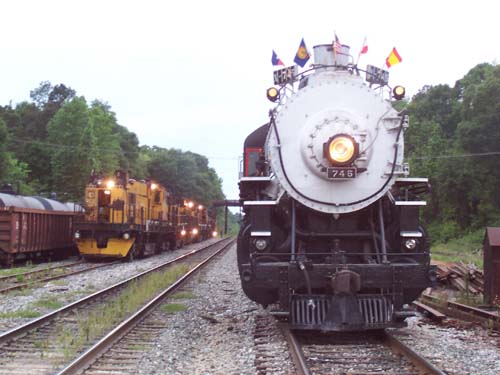
745 passes the rail grinder west of Simsboro, LA.
This is when things started to get complicated. The rail grinder had passed us by while we were parked in Simsboro. One of the high rail vehicles accompanying it broke down and fouled the main line approximately 6 miles in front of us. In addition, the tie gang was also still working a little further east and had the main shut down. We had four eastbound trains behind us and three westbound trains that we had to meet. The rod bushing on #2E was still running hot and we had to attempt to keep our scheduled speed so we wouldn’t further complicate an already dicey situation. Thankfully, the high rail was able to get into the clear and we continued past the tie gang who had gone into a spur track to clear up. .
There were a large number of folks present as we arrived in Rushton, LA. There was an overpass near Louisiana Tech that was absolutely packed with people and you could hear them cheering from overhead as we passed by. As we pulled up in downtown Rayville, the area was packed with people. We did another quick greasing on the problem rod bushing and were soon on our way.
We had yet another moment of excitement. I was running along at about 43 mph and was approaching a crossing. A railfan who was taking pictures gave me a washout (emergency stop) signal, pointed at the crossing and then gave me another washout. I immediately put the train into emergency and we were able to stop just short of the crossing. He was waiting to take a picture when a large dump truck drove over the crossing. One of the huge timbers in the crossing had popped up and was now pointed up toward the pilot on the steam engine. Had we hit the timber, the best we could have hoped for would be a bent pilot on the engine. I prefer to not think about the other alternatives. Needless to say, we shook his hand and gave him a big thanks and a 745 hat!
We took siding at Calhoun, LA near a school that had all the kids turned out to see the train and met the three west bounders before proceeding east. We also gave the problem rod a shot of grease while we were stopped. Ron Larson had been shadowing the train and we said our goodbyes to him as he was heading home to Austin after being our savior with the air pump.
As we entered Monroe, we passed through another defect detector and this time we triggered two alarms, the usual 5F but also 3E. Since we were about 1 mile from our “whistle stop” in downtown Monroe, we elected to keep going and do our inspection in Monroe. We were crossing the big truss bridge over the Quachita River in downtown Monroe when I noticed a videographer set up at the other end of the bridge. He had his tripod set squarely between the rails. As I got closer, I gave a few warning toots on the whistle and he wouldn’t move. I got within about 50 feet of him when I opened up on both whistles and he finally got the message and moved clear just in time. We went about 3 more blocks and spotted the train. The rod pin was completely dry and we pumped some more grease into it, but it was now so hot that the pin grease just turned to hot oil and ran right back out again. We elected to go a little further down the line to Magenta where we could stop next to a siding in case the dispatcher needed to run another train around us. The pin had cooled a little more, but now we couldn’t get the grease pump to work and the reservoir can was stuck on the pump. We pulled out the Alemite gun and were able to pump some grease onto the rod. Ray Duplechain and I had a brief discussion that it looked like we probably wouldn’t be able to make it to our overnight stop at Delhi, both from the standpoint of the hot rod bushing and the Hours of Service 12 hours for David and I was drawing near. I did some quick mental calculations and thought that there was a possibility that we could still make it. I found that if I kept the locomotive at around 30 mph, the rod wouldn’t get too hot as long as we stopped regularly to inject grease. However, we still had a “whistle stop” at Rayville to make along with some grease stops and I knew it was going to be tight.
We headed east and made it to Rayville where we doubled up on a “whistle stop” and put another shot of grease on the rod bushing. We headed down the line until it was about time to make another grease stop. I was running time calculations in my head and knew that we were now on an extremely tight window. I radioed back to Conductor Meyers and told him that we needed the grease crew to hit that rod like a NASCAR pit crew and t we had to clear up and be rolling in 5 minutes. They hit the rod with the Alemite gun, got a charge of grease on the bushing, and we met our time mark. We got within three miles of Delhi and I could sense that the rod was again getting hot. I did another quick calculation and radioed back that they would have 3 minutes to shoot the problem rod. By golly, the guys pulled it off and it now appeared that we could make it to Delhi mechanically, but would David and I run out of time? We had been doing a double spot at most locations to unload the ramps for the train and I radioed back that we’d only have time to get the train parked and would not be able to do the second spot. We pulled by the switch in Delhi, the switch was lined and the derail taken off, and we backed into the siding and stopped the train right on the minute of our 12 hours – much too close for comfort!
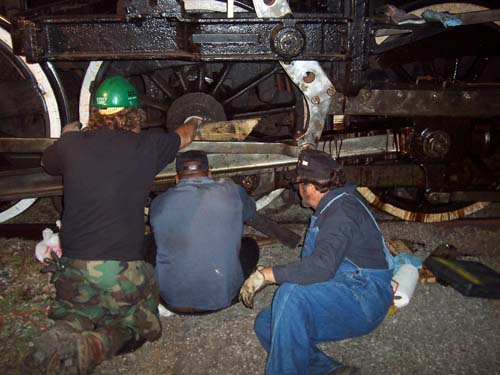
Mike Hankins, Ken Cotton, and Bill Morris remove the rod pin nut in Delhi, LA.
We loaded our gear into the Suburban and staggered to a local eating establishment to get a quick bite to eat and then went to the Best Western for the night. After the long, stress-filled day, I was really ready to crash and really slept well.
Tuesday, April 26, 2005
The skies turned ugly and we had a couple of nasty thunderstorms with brief periods of heavy rain roll through. In spite of this, the mechanical crew got to work. Ken Cotton, Jerry Lynch, and Mike Hankins pulled the nut off of the rod so we could get a look at it. As soon as the nut was removed, the news wasn’t good. The brass bushing had approximately 3/16” of it’s outer circumference worn away. We had a discussion about our options and we elected to see if I could find a machine shop in Jackson and we’d nurse the injured rod there so we could hopefully get a new bushing and insert made and installed during our full day layover there. I got busy on the cell phone and found a machinist that specializes in large equipment repairs. We pulled out of Delhi an hour behind schedule due to traffic on the line.
Despite the nasty weather in the morning, the afternoon turned out to be a beautiful day. We were traveling at a leisurely 30 mph most of the way so that we wouldn’t overheat the problem rod bushing.
We had another large group of chasers and also folks coming out of homes and businesses along the tracks. When we got to our “whistle stop” in Tallulah, LA, there was a large crowd waiting for us. We stopped for about 45 minutes and then we resumed our eastward trek.
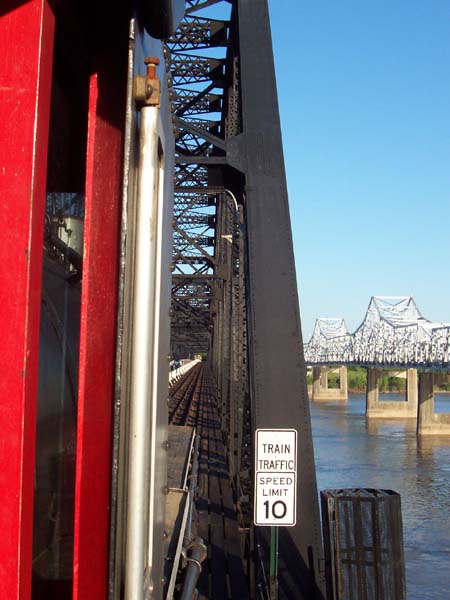
Crossing the KCS Mississippi River Bridge into Vicksburg, MS. The bridge on our right is I-20.
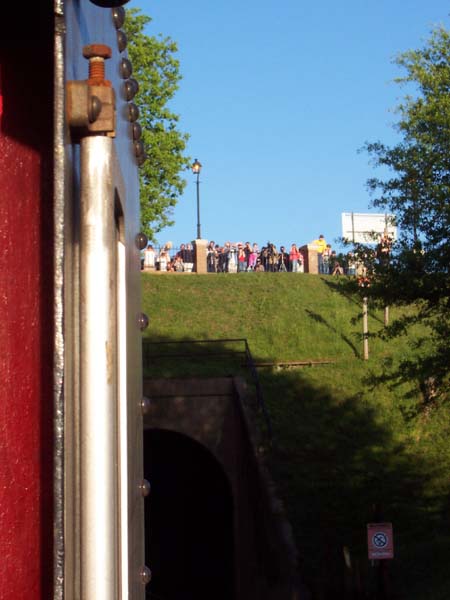
Getting ready to enter the tunnel into Vicksburg, MS at the east end of the river bridge. We had a lot of nice folks waiting to greet us!
We were within a half mile of the Mississippi River bridge when a bunch of folks came out of a bar that was close to the tracks. The engine got about 2 car lengths past the bar when we heard a loud report. Mike Hankins later told us that one of the bar patrons had gotten so excited that he discharged a pistol into the air and that was the report we heard. We crossed over the river bridge which was real interesting and entered a tunnel on the Mississippi side of the bridge. There was a large number of people at the overlook over top of the tunnel. We wound our way through the Vicksburg KCS yard and parked the train on a spur track right next to the old brick depot building in downtown Vicksburg. We stayed the night at the Horizon Casino Hotel.

Upon arrival in Vicksburg, we were privileged to have not one, but THREE ballerinas welcome us!
Wednesday, April 27, 2005
Our fuel delivery problems continue to plague us. The oil truck had broken down the night before and we weren’t able to get any #4 oil. We elected to buy 1000 gallons of off-road diesel fuel filling up the generator car tanks and putting the rest into 745’s tender. We pulled the nut from the problem rod and the cast insert around the bushing was now cracked, so it looks like we’re not going to be able to make it beyond Jackson without making a new shim and insert.
During the night, the Mississippi Queen riverboat had tied up at the levee next to the train. As we began our departure about 20 minutes ahead of schedule, we backed down the lead next to the riverboat. The Captain hit his whistle and the calliope was playing “I’ve Been Working on the Railroad”. I answered back with both whistles on 745 and the Captain and I spent the next couple of minutes trading whistle blasts.

745 and the Mississippi Queen in downtown Vicksburg, MS.
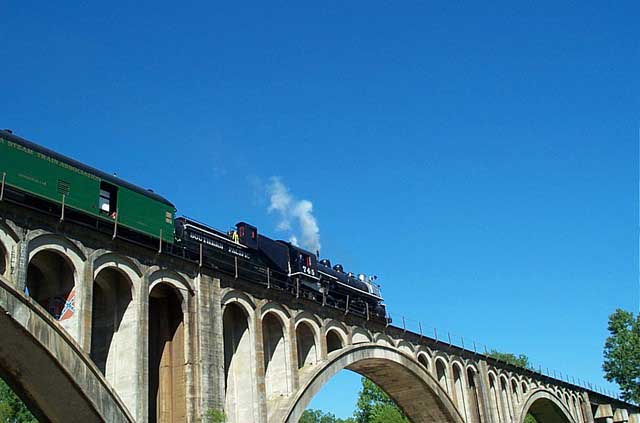
Crossing the spectacular bridge over the Black River in rural Mississippi.
We backed through the KCS yard until we could go through the crossover and over the switch that they would line to put us on the mainline to Jackson. The switch was lined and we started our pull up the 1.8% grade up out of the river bottom. 745 had no problem with the grade and I was really wanting to let her cut loose and walk up the hill, but prudence prevailed and I elected not to subject the problem rod bushing to any excessive pounding. We went up one more long grade and then stopped so that the “pit crew” could hit the rod with grease. We did this several times as we headed east and we soon entered the west side of Jackson. We heard a loud noise and discovered that a press helicopter was hovering right over top of the locomotive. The helicopter stayed with us for about ½ hour as we made our slow 10mph trek into downtown Jackson.
Amtrak’s “City of New Orleans” was sitting in the station as we passed by in the yard. We then crossed over the IC mainline and headed to Pearl, MS, a Jackson suburb, where we tied the train down. Jerry Mason from the machine shop showed up and the crew began pulling rods. We, along with some more of the LASTA crew and Jon Stern, our videographer, headed to town to find a motel and a place to eat. We got to town and checked into the Econolodge and then walked to Shoney’s for dinner. We were all pooped and called it a night.
I was exhausted and fell right to sleep. I was awakened around 12:45 am by the phone. The desk called to say that the hotel was on fire and we needed to evacuate. I quickly got dressed and went out to the parking lot and the hotel was indeed on fire and I later found out that the flames were shooting higher than the roof line of the building. Fortunately, there was a fire station across the street and they were able to knock down the fire quickly. However, it was quite some time before we were allowed to return to our rooms. The fire department had to confirm that the power was off to the damaged area but didn’t have any way to determine this. I showed the Chief my Electrical Contractor’s license and he put me to work running down and disconnecting the electrical circuits in the damaged part of the building. As he was having some of the fire fighters open up a wall so that I could disconnect some wiring, we discovered that the interior of the wall was still burning. They gave it a quick shot of water and the remaining fire was soon out. I ended up disconnecting about 8 electrical feeds so that the damaged part of the building would not have any power available to the damaged wiring. After that, we were all permitted to return to our rooms and the hotel owners thanked me for my help and refunded our credit card charges for David and I for the two nights we’re staying here.
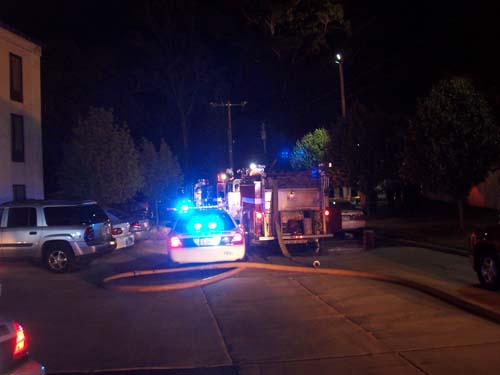
Our exciting first night in Jackson, MS.
Friday, April 28, 2005
Today was our scheduled layover day in Jackson. I ran over to the train and watched Mike Hankins, Levi Coulter, Jerry Lynch and the guys from Mason & Overstreet removed the rods from the engine. By about noon, they had the rods removed and Jerry Mason and his guys headed for their shop to machine some pieces for the rod. We stopped by this evening and checked on the progress and they had the machine work completed. They’re going to bring them back to the train early in the morning.
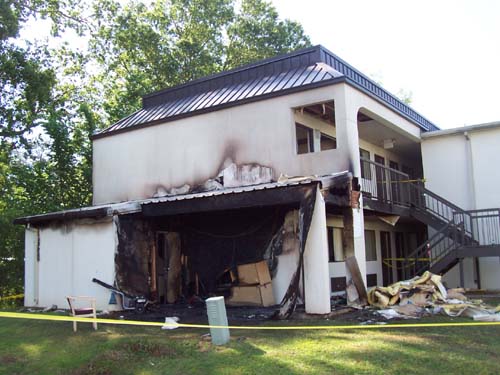
A view of our hotel the next morning. We were really lucky that the fire station was right across the street. The flames were over the roofline of the hotel when they arrived!
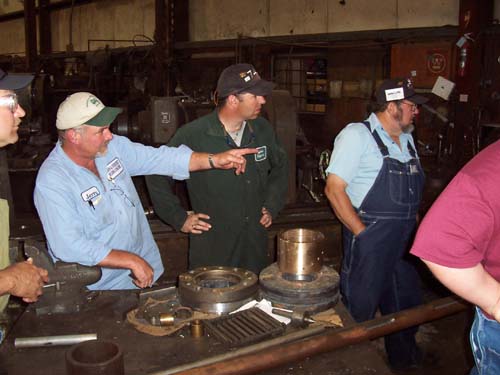
Jerry Mason of Mason and Overstreet Machine Shop describes the work he's doing on making a new rod insert. The brass rod bushing on the table has been dressed and is ready to go back onto the locomotive.
Friday, April 29 and Saturday, April 30, 2005
I’m tying these two dates together because of the kind of “day” we had. The Suburban’s developed a bad miss so I decided it give it a tuneup in the hotel parking lot this morning. It’s running a lot better, but has a really rough idle. I’ll have to check on this later.
We headed to the train and arrived about 20 minutes before our scheduled departure time. All the rods were back in place and Mike and Levi had the locomotive all greased up and Keith had everything else checked out and ready to go. I did the daily inspection, we did the air brake test, our pilots for both KCS and CN/IC were on board and we pulled about ¼ mile onto the main. Jerry Brown was our CN/IC pilot for the day. Keith spotted problems in the rod immediately and we checked and found that it was already excessively hot. We backed into the office car track from which we had come and worked on it some. The next time we pulled onto the main, the temperature was elevated but nothing like the previous time. We backed a considerable distance to the IC yard and checked the rod pin temperature before we headed out and everything was looking great. We ran about 8 miles down the line and the rod was again getting hot. We pumped grease into it and it cooled down and we headed south. We elected to go into the siding at Terry to check on the rod. It was still getting excessively hot, so we pulled to the depot to work on it. Unknown to us, a large crowd was gathered at the depot just to watch us roll by. Instead, they got to watch us work on the engine for over 4 hours.
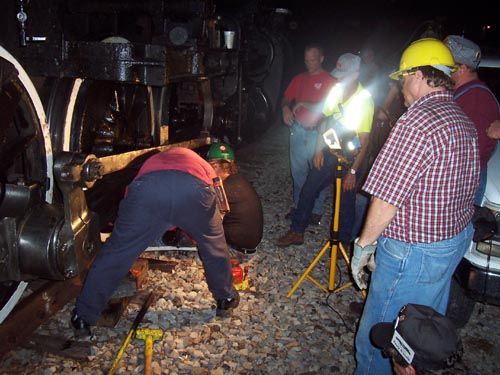
Fabricating and installing a shim at Terry, MS.
We determined that the flange on the nut was grabbing on the rod as the wheel was rotating. This was forcing the nut to turn against the keeper and wedge it tight. The nut was now so tight that we had to use a 20 ton hydraulic jack against the rod wrench to get the nut loose. A local gentleman brought a shop truck over and we used his acetylene torch to fabricate a shim that would go between the nut and the rod facing and give the proper clearance. We exercised the engine back and forth on the siding several trips and it looked like we had the problem fixed. We had to wait about another 30 minutes to get the electric lock to work on the switch to the main and we finally got on our way. We went several miles and checked the rod pin again. Although the temperature was a little elevated, it was doing considerably better.
Strong storms had been forecast for the evening and we had been watching the clouds gathering and there were frequent distant lightning flashes in the sky. We stopped again and shot the rod with some more grease, but were told that any more delays would put us in the hole for the night since there was a lot of traffic on the line and they were beginning to experience some weather delays north of us. The dispatcher came on the radio and said that there were 65 mph winds just north of us and that 6 funnel clouds had been spotted.
We were put in the hole to meet a northbound train so we elected to give the rod one more shot of grease. We would have to run 35 miles to McComb without stopping once we received the authority to hit the main. We were stopped for over an hour and the winds picked up and a light rain started. It didn’t last long and we mostly experienced some gusts of wind and lightning.
We finally received authority and pulled out onto the main. I found that keeping the locomotive at 30 to 35 mph would keep the problem rod bushing at a reasonable temperature, so we held that speed and rolled into McComb without triggering any detector alarms, except for the usual 5F, and tied up at 6 am. They had counted David, Willy and I as off duty for the over 4 hours we were in Terry and this allowed us enough operating time to stay within our hours of service. We said our goodbyes to Jerry Brown and Asst. Supt. Evans who had been shadowing us in a railroad Jeep Cherokee. I really enjoyed visiting with Jerry and talking farming and old tractors with him.
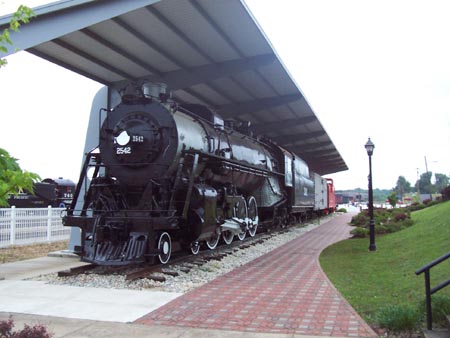
Retired Illinois Central Mountain Type 2542 on display at McComb, MS.
We were really whipped and Ray Duplechain drove David and I to our hotel and let us out and drove away. When we got into the hotel, we were told that we had missed the time for our reservation and that we could only have our rooms until 1 pm. Since we desperately needed rest, we elected to pass on the rooms and I walked next door to the Deerfield Inn and found rooms for both of us and we were finally able to get some rest. Later in the day, Bill Morris brought the Suburban to us and we were able to get our luggage and some clean clothes. I also found a vacuum line loose on the engine and that fixed the rough idle problem so the Suburban is now good to go.
We returned to the train which was parked across from the McComb Amtrak Station. I was able to spend a few minutes walking around the 4-8-2 Illinois Central steam locomotive that is on display. It’s pretty complete, stored under a shelter, and painted up quite nicely so it’s being preserved. There’re also a couple of other pieces of rolling stock under the shelter with the locomotive. McComb used to have quite a shop facility and there’re some remnants of the glory days here in the way of the old roundhouse foundation and other shop building remnants.
We departed on schedule at 7:30 and got out onto the main. I kept 745 at 30-35 mph and we stopped halfway to Hammond to inspect the rod. It was doing pretty well and Mike put a precautionary shot of grease on the problem pin. I checked temperature on everything else and we were in great shape. We whistled off and continued our trek south. It was interesting to see the string of headlights following us on US 52. I’m sure that a few were railfans shadowing the engine and the rest were some hapless travelers who had to misfortune to get stuck behind the road block. A few were getting a little too aggressive and law enforcement was quite busy writing tickets.
There was a carnival in Hammond and there were a large number of folks out to greet us when we arrived. We slowly backed the engine onto the old roundhouse lead and tied the train down for the night. The problem rod bushing did fine and we were most thankful to finally have an easy working day. We headed to the Best Western south of town by I-12 and got some welcome rest.
Sunday, May 1, 2005
I had to get up early this morning so we could move the train. We needed to do a final spot on the train so that the entrance ramps could be set up. We then uncoupled the locomotive, pulled ahead about 3 car lengths, and backed the engine onto the southeast leg of the wye track where it was displayed for the day. After tying down the locomotive, I was talking to one of the local law enforcement officers who told me that their 911 call center had received at least 3 calls the night before about a southbound train that was on fire. One of the callers was a Louisiana State Trooper. They were seeing the flame coming out of 745’s firebox draft door. The firebox in 745 really throws out the light to the sides making an almost strobe-like effect when she’s working on the mainline after dark.
We got back to the train in the mid afternoon and spent time visiting with the public who were visiting the train. About 5 pm, we moved the engine back onto the cars and did our inspection and air brake test. It was decided that we could leave a little early as long as we could clear up before a southbound hotshot got to us. We pulled to the electrically locked switch and they were unable to get the switch to operate. We had to back into the clear and let the southbound get by us and then we tried again. The switch worked this time so we pulled onto the main, backed past the Hammond, LA depot to the signal north of the connector track, then pulled through the connector onto the line to Baton Rouge.
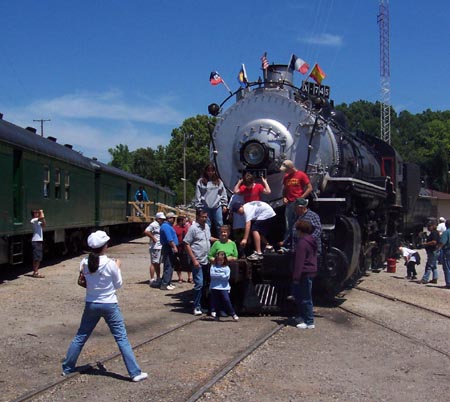
Who says young folks don't love steam? Some of 745's young admirers in Hammond, LA.
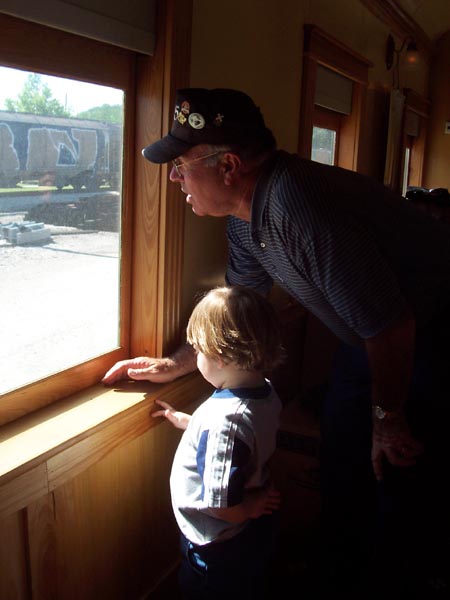
Ray Duplechain teaches a young visitor some of the finer points of railroading. This junior engineer couldn't have a finer teacher since Ray was a Superintendant on both the Southern Pacific and the New Orleans Public Belt Railroads, General Manager for the SP Railroad, plus he's just a great guy that loves people!
The branch to Baton Rouge was about 43 miles long and had 129 public grade crossings! We had the bell and whistle going almost the entire trip. The western end of the line took us through even more congested areas and we were at 20 mph through most of this part of the line. We pulled over the interlocking with KCS and proceeded to the wye where we turned the train. We pulled back to the KCS interlocking and pulled onto the connector where we said goodbye to our CN/IC pilot Leon David. KCS Manager of Operating Practices Ted Wax was there to pick us up as our pilot and it was like a reunion since Ted had been our pilot for all the test runs and for the first KCS segment of our journey. We pulled the train down the main to the KCS yard office and tied down for the night. David and I headed for the Comfort Suites off of I-10 and College where we stayed the night.
Monday May 2, 2005
It was one month ago today that we made our grand departure over the Huey Long Bridge and took 745 for her first trip on her old home rails. In one way it seems like we left a year ago and in another only yesterday. Today the 745 and the LASTA crew turn toward home.
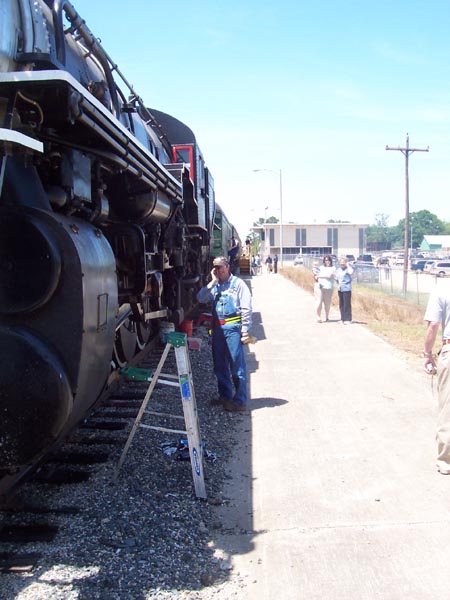
"Homeboy" Keith Bonnette services 745 in his hometown of Baton Rouge. Keith is a vital member of the steam crew as well as serving as 745's FRA Compliance Officer.
David ran the engine today and I took the day off to chase the train and experience 745 from the perspective of the thousands of folks who have seen her over the past month. It felt a little strange to drive slowly away from the train as the final departure procedures were being performed, but it also helped me start the adjustment toward returning to real life.
I drove over to Perkins Lane and waited in a driveway to a bridge contractor. I heard David and Willy making the brake test over the radio and heard them talk about departing. I have to admit that my heart was feeling a little empty and strange to not be a part of the operations, but in another way it felt good to think that 745 was in good hands. It seemed to take forever and then I finally saw the plume of smoke, heard the whistle, and 745 came rolling by.
There truly is something almost spiritual about a steam locomotive in motion. The motion of the drivers, the plume of smoke, and the sound of her “breathing” as she passed by was truly a sight to behold. I got caught up in the rush hour traffic so I got onto I-10 to try to catch up to the train further down the line. I came to the KCS overpass just after she passed underneath and the traffic slowed on the Interstate because of the smoke. I was able to leap frog the train several times and really enjoyed watching it roll by and it also gave me a chance to visit with some nice folks along the way.
As the train approached Mays Yard, I heard MOP Ted Wax on the radio trying to get a ride to the KCS New Orleans Yard and the yardmaster told him that there may be quite a wait for a ride. I go on my radio and offered Ted a ride which he accepted. I drove over to the tower at Mays Yard and pulled in just as the train was arriving. Ted got in the Suburban with me, the CN/IC pilot boarded 745 and we went our separate ways. It was nice to have the opportunity to visit some more with Ted as he’s been just a super individual with which to work. Ted shared with me that he was really sad that the adventure with 745 was coming to an end and I certainly commiserated with him. I dropped Ted off at the KCS New Orleans Yard Office and headed back for the train.
The LASTA train had pulled about a mile down the lead from the Mays Yard wye and I had problems locating it. I spent about 20 minutes listening to communications on the radio but couldn’t locate where they had gone. I finally found the train just as they were pulling up to Mounes Avenue and this is where the train tied down for the night.
Bill and Marie Morris, David and I decided to get a late dinner and went to four restaurants before we found one open. We ate at Denny’s on Clearfield which is right next to the approach to the Huey Long Bridge. It seemed a little strange that we had taken the steam train over that bridge just a month ago. We all had a good visit and then David and I headed back to the Quality Hotel on Causeway which has about become our second home.
Tuesday, May 3, 2005
Most of today was spent cleaning the remaining tools and packing everything up in the Suburban. The train got a good cleaning for a reception that was held in the Jefferson car this evening. Jefferson Parish President Broussard visited with us for awhile and a good number of the crew were present as this was the last time that many of us would be together.
Wednesday, May 4, 2005
David and I had an interesting diversion this morning. We had befriended Marty Soholt who is the Trainmaster of the American Orient Express. The AOE had tied up at the New Orleans Public Terminal and Marty extended an invitation for us to tour the train which we immediately accepted. It was fascinating to tour such a beautiful train which is fitted out much more finely than any American passenger train of the glory days of US railroading, save for some private varnish. After the tour, we headed out for our train and Marty came along to see 745.

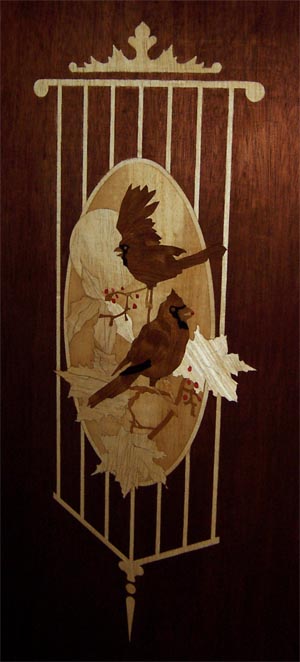
Some of the 5-Star dining accommodations on the American Orient Express and one of the intricate inlaid panels in the car.
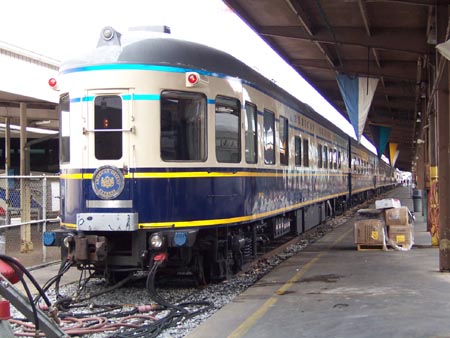

This is an exterior and interior view of the exquisite observation car on the rear of the American Orient Express. It was once the observation car on the rear of the famous 20th Century Limited and was photographed many times carrying many famous people over the years and is quite an historic piece of equipment.
We steamed her up for the last time today. I decided to tie the stuffed ‘possum “Dumplin” on top of the headlight for the trip home. We’d adopted her at the Cracker Barrel Restaurant in Shreveport. The train was opened up to the public for the last time this morning and closed this afternoon. We started backing up on the lead at around 16:45 this afternoon. The weather was nice and it was great to have the trip both begin and end with such beautiful weather. KCS MOP Ted Wax was with us again for the last trip and said that he was sad to see it coming to an end and we certainly agreed with him. Ted was a major part of all the test runs and also started and ended the grand adventure with us and it was sad to say goodbye to him at Lambert Junction.

745 with some of the Jefferson Paris peacekeepers at Harahan, LA.

"Dumplin" the 'possum on her perch on the headlight. (No PETA, she ain't real!)
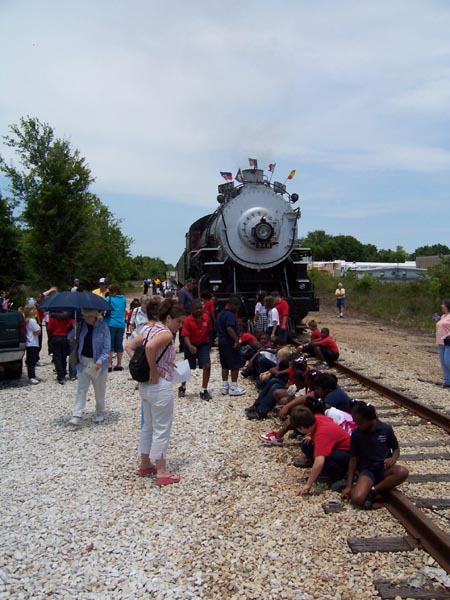
This school group in Harahan, LA was one of the last of the thousands of kids and thousands of adults who visited the train during the tour. Unfortunately, the ramps would soon be loaded up and the cars closed up for transit for the last time and our grand adventure would soon come to an end.
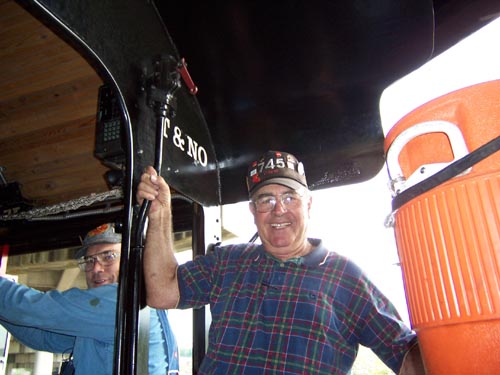
Ray Duplechain and myself in the cab of 745 as we start the final move of the great adventure.
While we were waiting for the NOPB to pick us up, the NOPB 2001 went by with the office car City of New Orleans in tow and General Manager Jim Bridger and a number of guests were on the back platform when it went by. I radioed to 745 and Keith Bonnette did a nice job with a whistle tribute when they went by. It was also nice to end our trip by waving to Jim since the NOPB had done so much to support us as well. They pushed us onto the LASTA lead and then cut off and backed away. I pulled forward around the 16 degree curve and had a little problem with the drivers slipping due to grass that had grown over the rails. As soon as I got the engine through the gate, I got off of 745 and turned her over to Bill Morris so he could bring her into the yard and finish the trip.
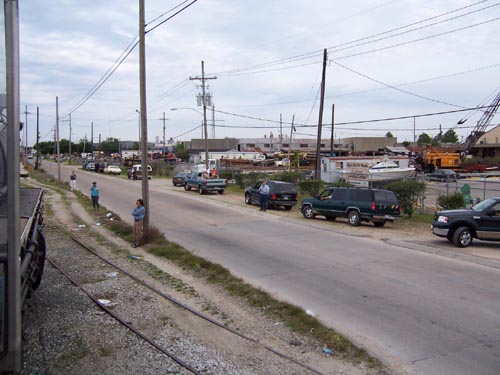
Some of 745's many fans came out to say goodbye as we headed through the Kansas City Southern's New Orleans Yard on the way to the LASTA yard and the completion of the trip.
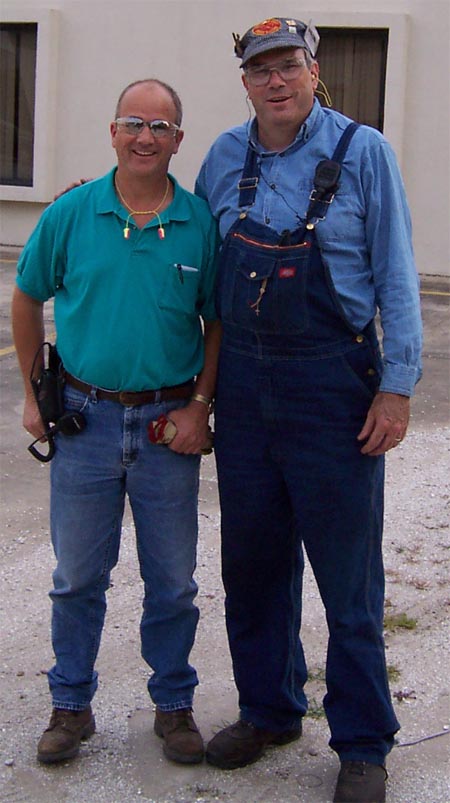
Saying goodbye to KCS MOP Ted Wax at Lambert Junction. Ted had played a vital part of our testing and regular operations of the trip and it was sad to see such a great adventure coming to an end for both of us, as well as the rest of the crew.
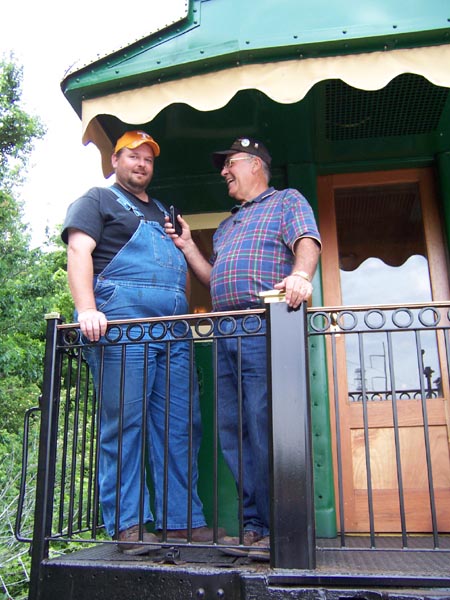
Ray Duplechain interviews Fireman and CoEngineer David Bartee on the rear of the Jefferson car while the train sits at Lambert Junction. It was a pure pleasure having David as my operating partner except, as a University of Kentucky alum, I hate his choice of hats!
We closed the event with a gathering of the crew and a final prayer which included a thanks and prayer for Gregg Dodd who had done such a marvelous job of restoring the locomotive. We rounded up the a few final pieces of equipment and David and I hit the road to start the long drive home. As we were leaving, one of the crew blew a goodbye to us on 745’s whistle as we headed down Jefferson Highway. We drove to Mobile, AL and stayed the night in the Comfort Suites just west of town.

"Dumplin" the 'possum made her ride in fine style!

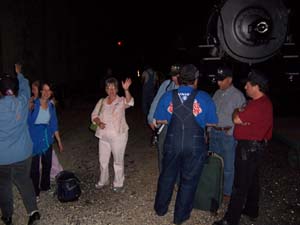
Now for the hardest part of our trip, saying goodbye to all our wonderful friends and teammates!
Thursday, May 5, 2005
David and I got up early and headed over to visit with our old friend J.R. Phillips. J.R. is a living encyclopedia of steam knowledge and knowing him is a true gift for us younger folks who are running steam. J.R. fixed us up with some tools and supplies for Big South Fork Scenic Railway and sent us on our way.
Our adventures were not quite over. We were traveling north on I-65 and were just entering the southern limits of Montgomery, AL. We heard on the radio that a high speed chase was being terminated and both southbound and northbound lanes of I-65 were being shut down. We immediately took the next exit and used the GPS to plot a bypass route around the problem area. We later found out that an inmate coming back from a capitol offense hearing had overpowered a deputy and stolen his cruiser. He shot at some officers, wounding a state trooper before he was shot and killed by law enforcement right in the middle of the interstate.

"Dumplin" gets one up on "Chicken" who had ridden on the front of 745's tender the whole journey and who was obviously quite exhausted after the big trip. David and I were too - I lost 16 pounds!
We arrived in Knoxville, TN around 21:00 and David’s family met us by the interstate. David had missed his son’s 6th birthday which had been two days before and his 3 year old daughter Kasey had really missed her daddy so it was nice to see them reunited. I finished the drive home and arrived home just after midnight.
It was a true gift to be a part of such an event. It was a pure joy to watch the team come together so cohesively and effectively. It seemed like God was looking over our shoulder as it seemed like solutions to special problems or needs would seemingly magically appear as the trip progressed. The successful conclusion of the trip was a culmination of hundreds of people’s efforts. Bruce Brown started the dream and so many great folks and businesses embraced and became a part of the dream. To the businesses and suppliers who donated supplies, to the officials of Jefferson Parish who helped secure funds, to Greg Dodd who performed such a magnificent restoration of the locomotive including a lot of his own money, to Amtrak, New Orleans Public Belt Railroad, BNSF Railroad, KCS Railroad and CN/IC Railroad for all their faith and support, to the LASTA members who tirelessly worked to restore the equipment, to our spouses and family who supported us so much with love and patience, to the businesses and individuals who stepped forward to help us during our special times of need during the trip, to the fans who gave us such moral support, to my fellow operations team members, and to God himself I’d like to give my heartfelt thanks for letting me be a small part of such a magnificent happening! I’m also most thankful for all the special friendships I’ve made as a result of this wonderful event!
In final thoughts, we’re well into the restoration of our steam locomotive in Stearns, KY at the Big South Fork Scenic Railway (www.bsfsry.com). Needless to say, this type of restoration is a long and expensive undertaking. I usually get asked several times a year if our old 1942 ALCO S-2 is a steam or a diesel locomotive (it’s a diesel) and it reminds me that we’re now at least three generations down the road from the era of steam. As a McCreary County Heritage Foundation Board member, I’ve had reservations that we may be putting a large amount of resources into a piece of equipment that no longer has any relevance or appeal to the modern populace. While I love and wholeheartedly support the restoration and operation of steam locomotives, I worried that my enthusiasm was that of a myopic hard-core steam fanatic and not that of the general public. My doubts where overwhelmingly quashed with my experience with 745 and with the tremendous amount of young adults and children who came out to see the train and the high level of excitement with which they greeted and embraced us. A steam locomotive is about as alive as a piece of equipment can be and there’s an almost spiritual quality about steam that speaks to folks souls who’ve been fortunate enough to experience one. It’s now quite obvious that there will always be a special place in the hearts of the beholders of steam regardless of age and I’m really looking forward to once again hearing the stack blast of ol’ #14 echoing off the sides of those beautiful Kentucky mountainsides as she shoves the grade!
Who knows, maybe I’ll get to take Deana Mae for a cab ride sometime!
Thanks for reading my messages. Come visit us at the Big South Fork Scenic Railway sometime soon!
Bill Johnson, Engineer 745


1942 ALCo S-2 exits the tunnel on the BSFSRY. The shot on the right is an engineer's view of the train just west of the tunnel. The picture is in example of the 3 1/2% grade that the train must negotiate as the line drops 600 feet in 5 miles.